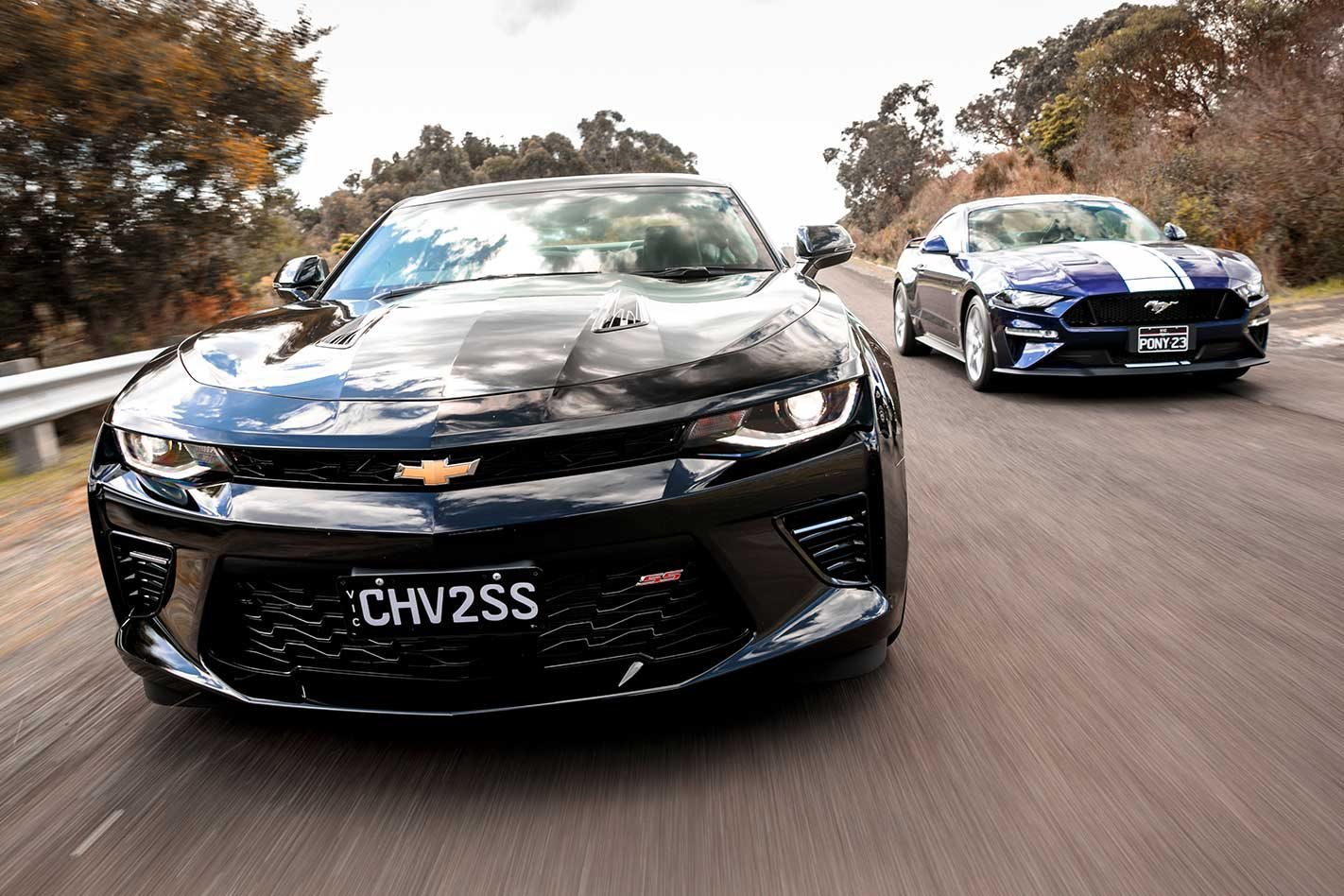Thunder. That’s what erupts after pressing the round, polished button labelled ‘ENGINE’ on the Ford Mustang GT’s centre stack. Throttle intensifies its barrage. And you instantly suspect this might be the best sounding car under $100,000 – except, maybe, for the ominous Chevrolet Camaro that’s about to fire up alongside it.
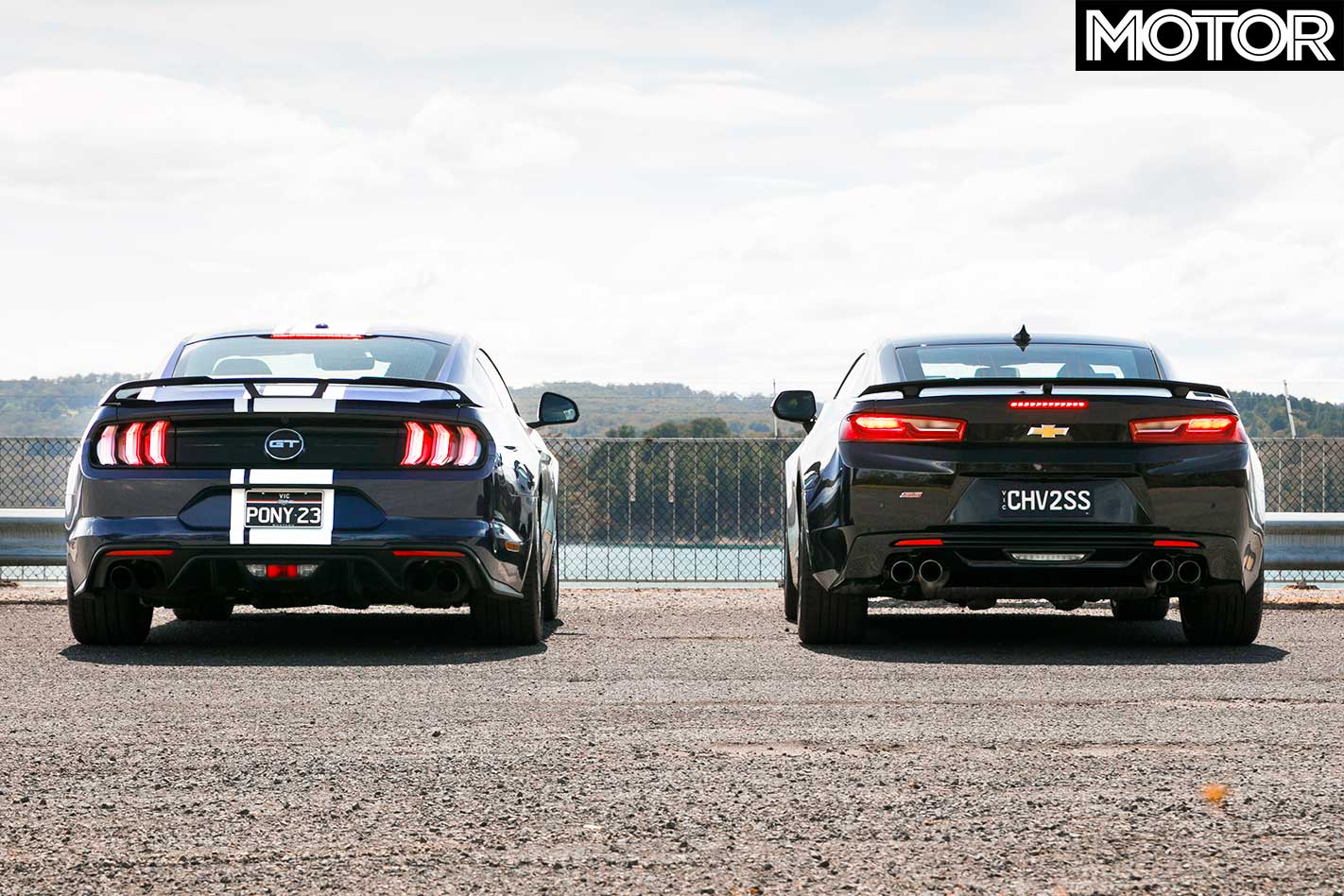
Together they are writing the sequel to the Australian rear-drive V8 performance sedan. It’s been more than a year since Holden shut off its local factories. Yet while Ford V8 fans have feasted on the Mustang since 2016, it’s only now that the GM faithful are getting their equivalent fix. And it’s all thanks to the fine folk in Clayton at Holden Special Vehicles.
HSV zeroed in on the Camaro after learning GM would kill the V8 Commodore. It successfully gained approval on a right-hand drive project in 2015 and now, with Chevrolet’s sixth-generation V8 bruiser finally ready, it starts a new Red and Blue rivalry that feels particularly nostalgic.
They’re both remarkably similar to each other and our bygone boof-heads. They count eight cylinders each, drive the rear wheels and are only just short of five metres. But while they’re separated by a couple thousand dollars back home, the scales aren’t so even in Australia.
HSV virtually rebuilds the car in Clayton. Its firewall is redrilled, its loom is rewired, the footwells are modified and it’s completely stripped during the process. This inflates its cost well above the Mustang that leaves its Michigan factory (only a couple hours’ drive from the Chevrolet one) with the steering wheel on the right side. But we’ll get to dollar figures later.
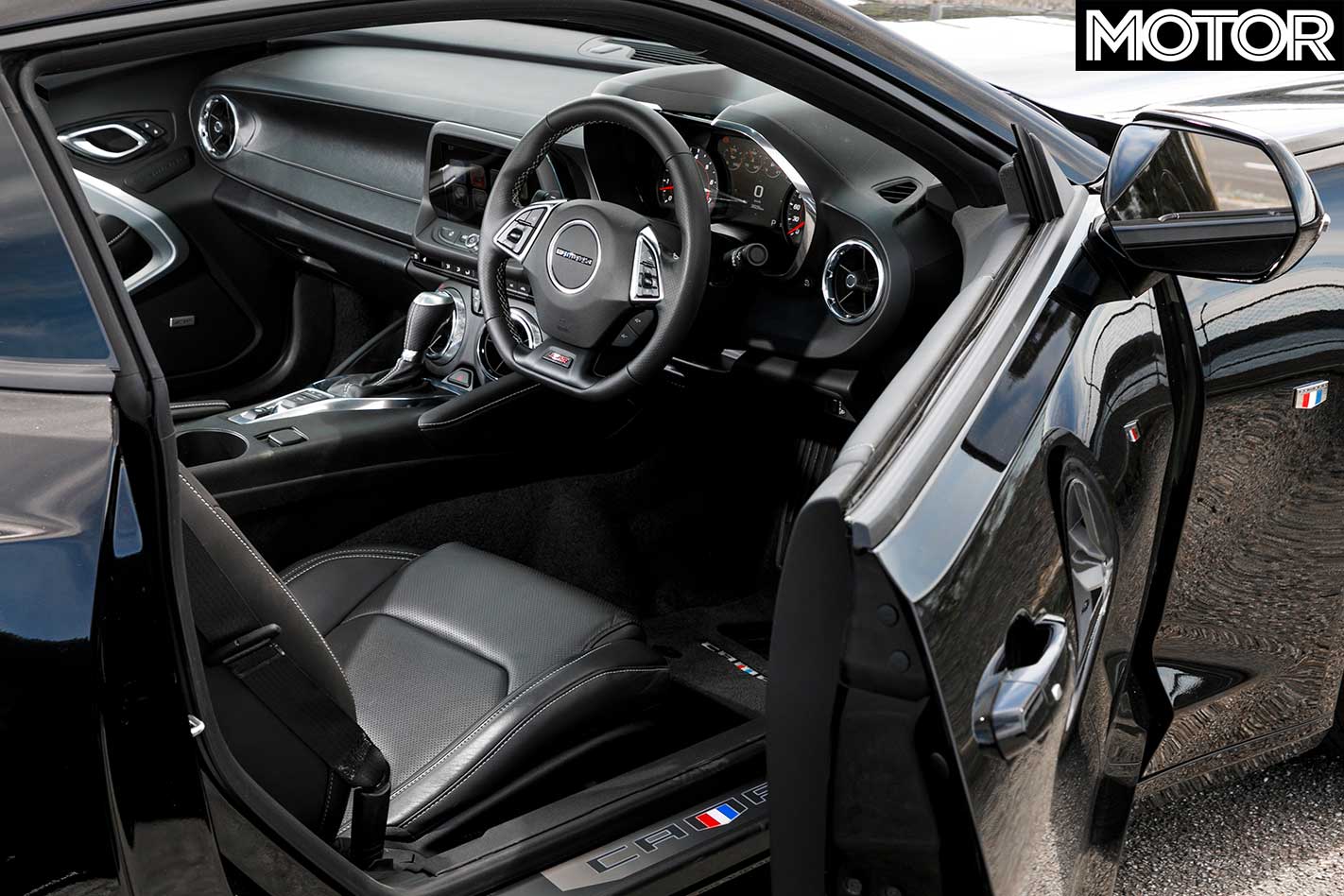
HSV also uses Argentinian core vehicles, not because someone at GM’s shipping docks misread the destination address, but because their car offers the most ADR compliant parts. This saves development costs, but it’s also why, for now, HSV offers the Camaro only in 2SS trim. The ‘2’ means it packs more fruit like Bose audio, interior mood lighting and power seats with heating and ventilation.
Argentina must be sunny because, whether you like it or not, every single car also comes with a sunroof. Meanwhile, the restricted spec also means Magnetic Ride Control, Recaros, different style wheels and styling packs are all missing from the HSV brochure, even though they’re available in America.
Ford’s product planners enjoy much more freedom. After ludicrous success in both left- and right-hand drive markets it’s revamped the Mustang to keep a firm grip on a sales lead it has back home. The new car’s aerodynamics are slipperier, the engine is more powerful, the suspension is sturdier, while the interior and styling ooze more appeal.
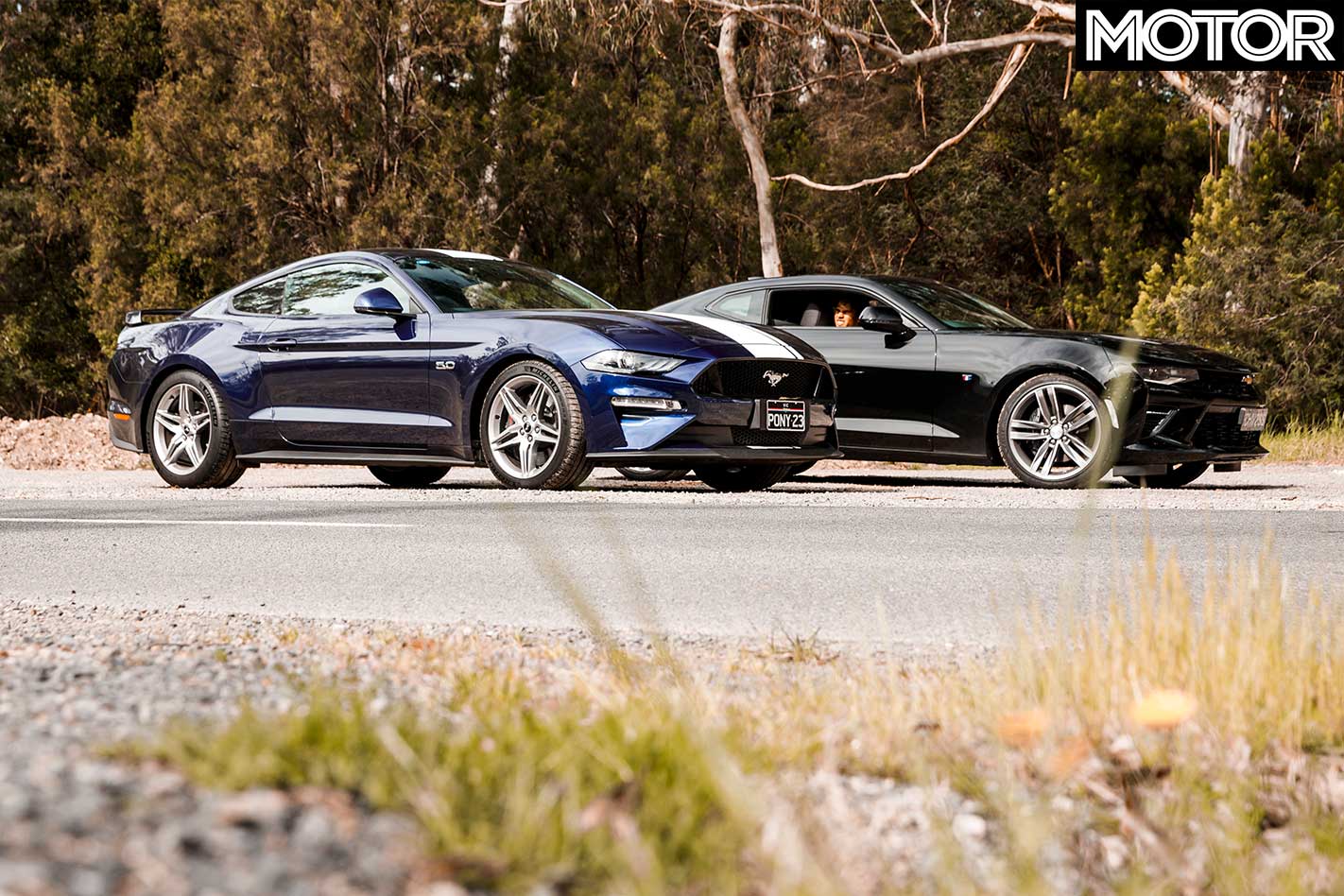
Our Mustang also flaunts a slew of new options made available for the 2018 model year. It’s fitted with the new optional ‘off-the-deck’ rear spoiler ($750), forged 19-inch racing wheels ($2500), Recaro seats ($3000), adaptive dampers ($2750) and racing stripes ($650). Most importantly, it features the new 10-speed torque converter automatic that, in its early stages, was co-developed with GM.
You’d think swapping cogs yourself would crown you king in a Mustang GT, but an automatic honed for the track and strip with specialised modes suit the bigger, brawnier Coyote V8 perfectly.
That engine enters a third generation of tune after engineers plasma coated its bores, fattening capacity by 84cc, and redesigned its cylinder heads around larger valves. There’s dual-fuel injection and a higher redline, too, of 7400rpm.

We’ve all seen a V8 ‘SS’ wearing bow-tie badges before, but now the link is bona fide. While the Camaro’s LT1 engine shares its 6162cc capacity and bore spacing with an LS3, new variable valve timing, direct injection and cylinder deactivation curb its consumption and lift power. A redesigned rotating assembly for the pushrod small-block, along with new high-compression pistons, also helps it spin to 6500rpm.
It develops 339kW at 5700rpm while the Mustang’s double overhead camshaft arrangement, also breathing through an 80mm throttle body, produces the same grunt at 7000rpm. The matching power numbers are more an inconsistency than coincidence.
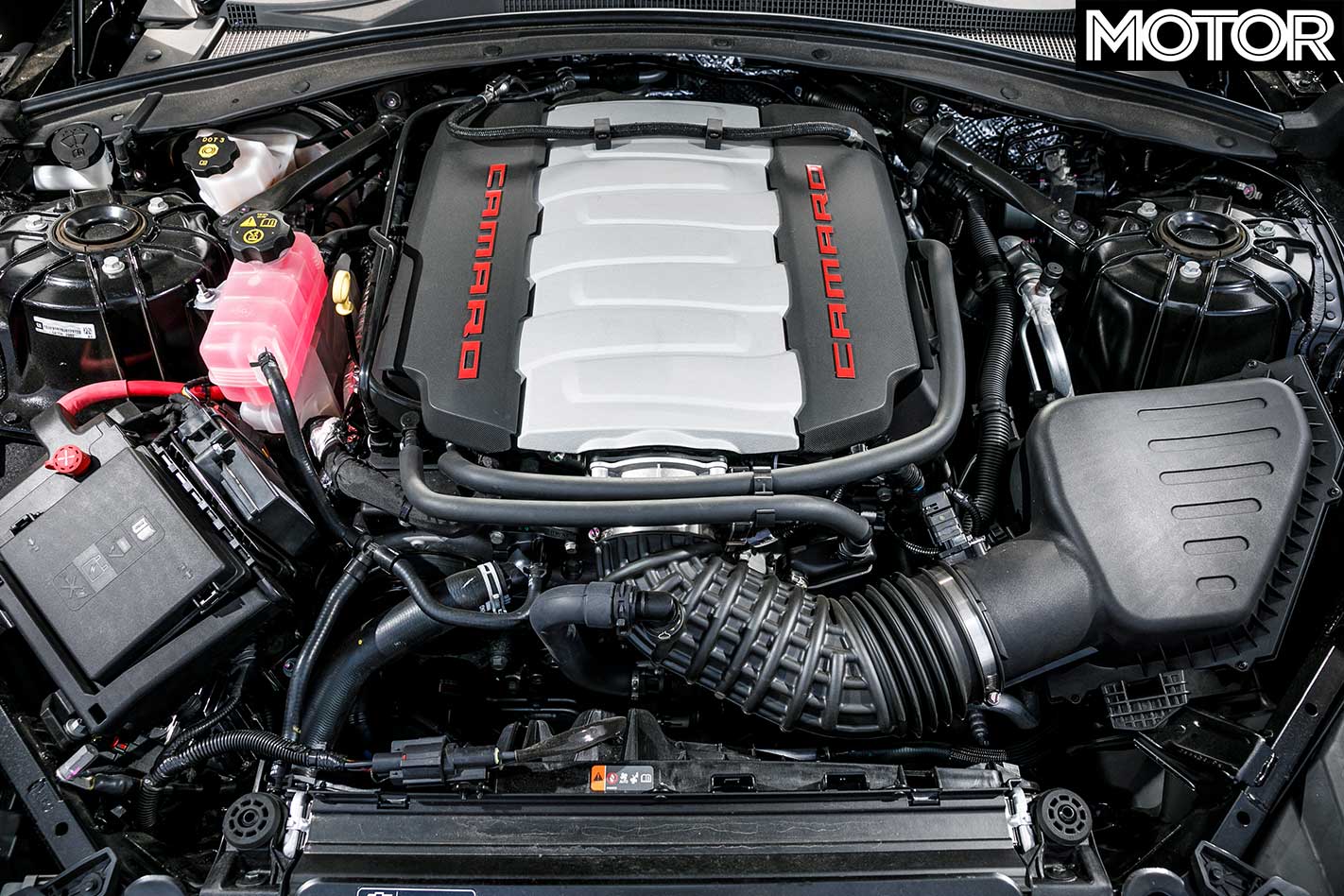
Ford’s quoted 339kW is gained from DIN testing methods, where engineers leave the exhaust and ancillaries on the engine during its dyno run. The Camaro’s power figure, however, is achieved using an SAE method carried over from America that tests engines on the dyno without power-sapping accessories.
No matter how much the DIN test would dock the Camaro’s figures it still would easily hose the Mustang for torque. Each car makes maximum torque at an identical 4600rpm, but the Camaro’s 617Nm towers over the Mustang’s 556Nm.
That might be why Ford huddles the 10-speed transmission’s ratios so close together. Direct drive is seventh gear and, unlimited, it runs to 293km/h. Meanwhile 1:1 in the Camaro is sixth and is geared to 310km/h.
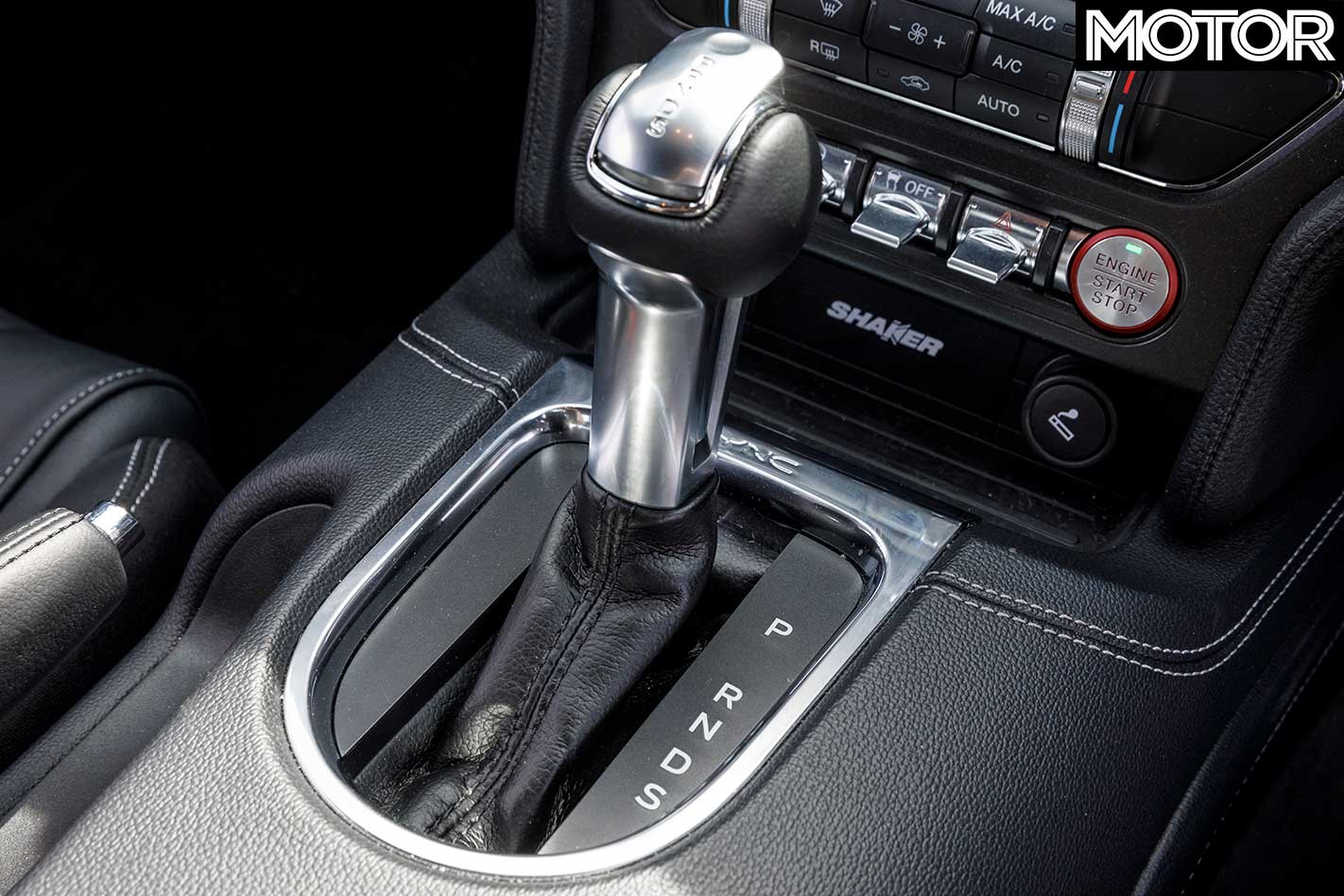
Can the Camaro prove there’s no replacement for displacement? Heathcote Raceway’s drag strip will answer that. You’ll find its circle-shaped starter button to the right of the centre screen. Prod it and the LT1 explodes into life with a hard-edged growl. The noise is dense and yet, when you tickle the throttle, it bursts into a free-revving roar.
After building a 1500rpm stall against the 8L45 transmission, we roll into the throttle. Grip is good, even in its looser ESP setting called StabiliTrak, but the times aren’t. Manufacturer claims suggest 100km/h should drop in 4.4 seconds with the automatic. We’re getting 5.5sec, 13.5sec at the quarter and 180km/h on the Driftbox.
We squeeze the brakes harder next time. The revs creep to 2000rpm on the stall, then we feel out the launch, bleeding off the brakes smoothly before stomping the throttle when there’s enough grip. With 275mm wide Goodyears we get away with small chirps of wheel spin. Triple figures arrive in 5.0sec flat and the quarter mile in 13.0sec. Top speed bumps to 182km/h.
We go through more runs without much improvement until we switch to manual mode. It nets an instant gain, dropping quarter miles into the 12.8sec range, by letting the engine wind out to redline rather than upshift early. Soon 4.68 seconds to 100km/h and a pass of 12.8 with 181.76km/h flashes on the Driftbox screen and we know that’s it.
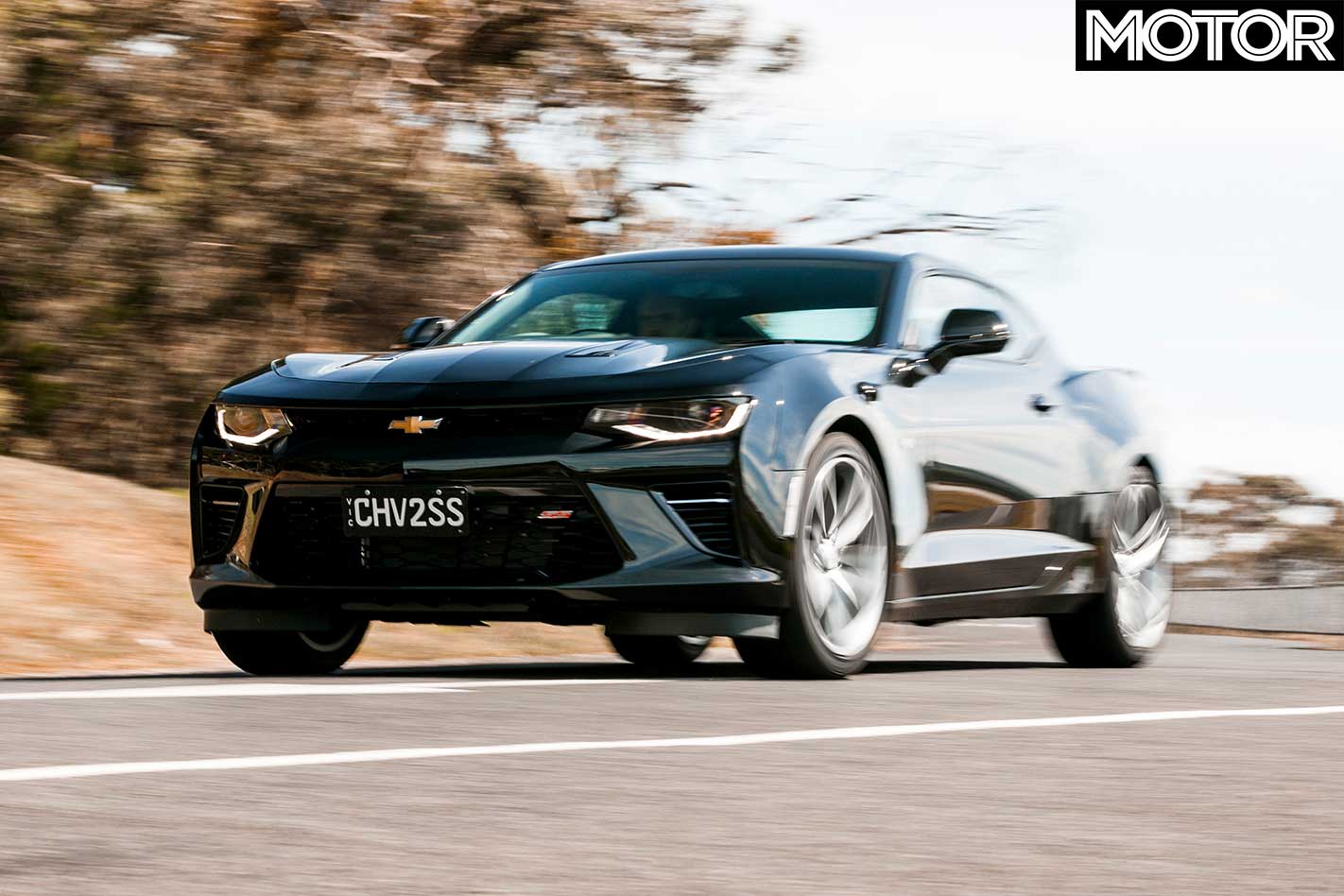
Time for the Mustang. Right away we understand why the new gearbox’s Drag mode is its party piece. We spend the first run catching the rear end as it dances down the strip. The mode keeps torque flowing during shifts, so the force of each engagement is so savage, ESP has to be turned off to let the car move around. Make sure you’re caffeinated before trying it.
A few more runs inject crucial heat into the tyres, slashing times to 4.95sec/12.89sec while lifting trap speeds to around 187km/h. But with surface grip not as good as it could be, it musters a 2000rpm stall before the rear Michelin Pilot Sport 4 S tyres start grating against the surface.
The next run nets its fastest figures. They’re a marginal improvement, and slower than the Camaro, but the fact we’re well into fifth gear over the line with another 6km/h hints at its potential. We’ve extracted 4.59sec/12.49sec from a grippier runway, however, we can’t spend all day tearing down the drag strip. Falling trap speeds suggest rising cylinder head temperatures could be sapping engine power. Besides, there are a lot things going on underneath these cars that are worth roads more winding.
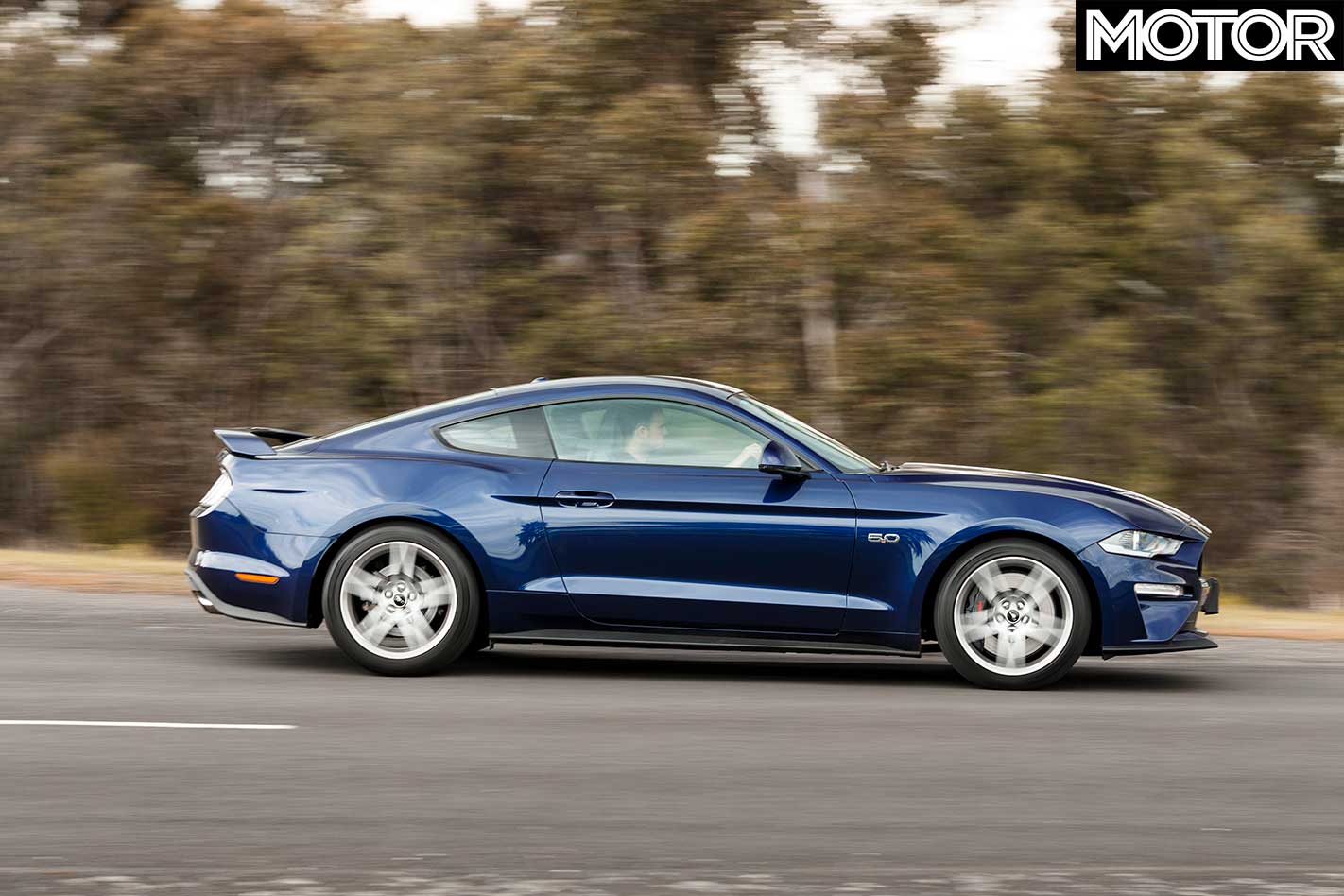
These muscle cars now pack the chassis smarts to chase down hot hatches and mug them for their lunch money. Their layouts are harnessed by front struts and multi-link rear suspension that control staggered tyre widths.
Beefed-up front knuckles for the Mustang’s adaptive suspension find more purchase and the tweaked rear-end is more controlled under power. It also sits nice and flat through corners until the odd lump exposes lingering rebound and float.
Poke it and it can bite, without warning, too, thanks to mute, but precise, electric steering. Luckily, if you get into trouble, its six-piston Brembos bite fast and hard. They react sensitively to slight brake pressure, which is more welcome when the Mustang’s 1756kg barrels into corners.
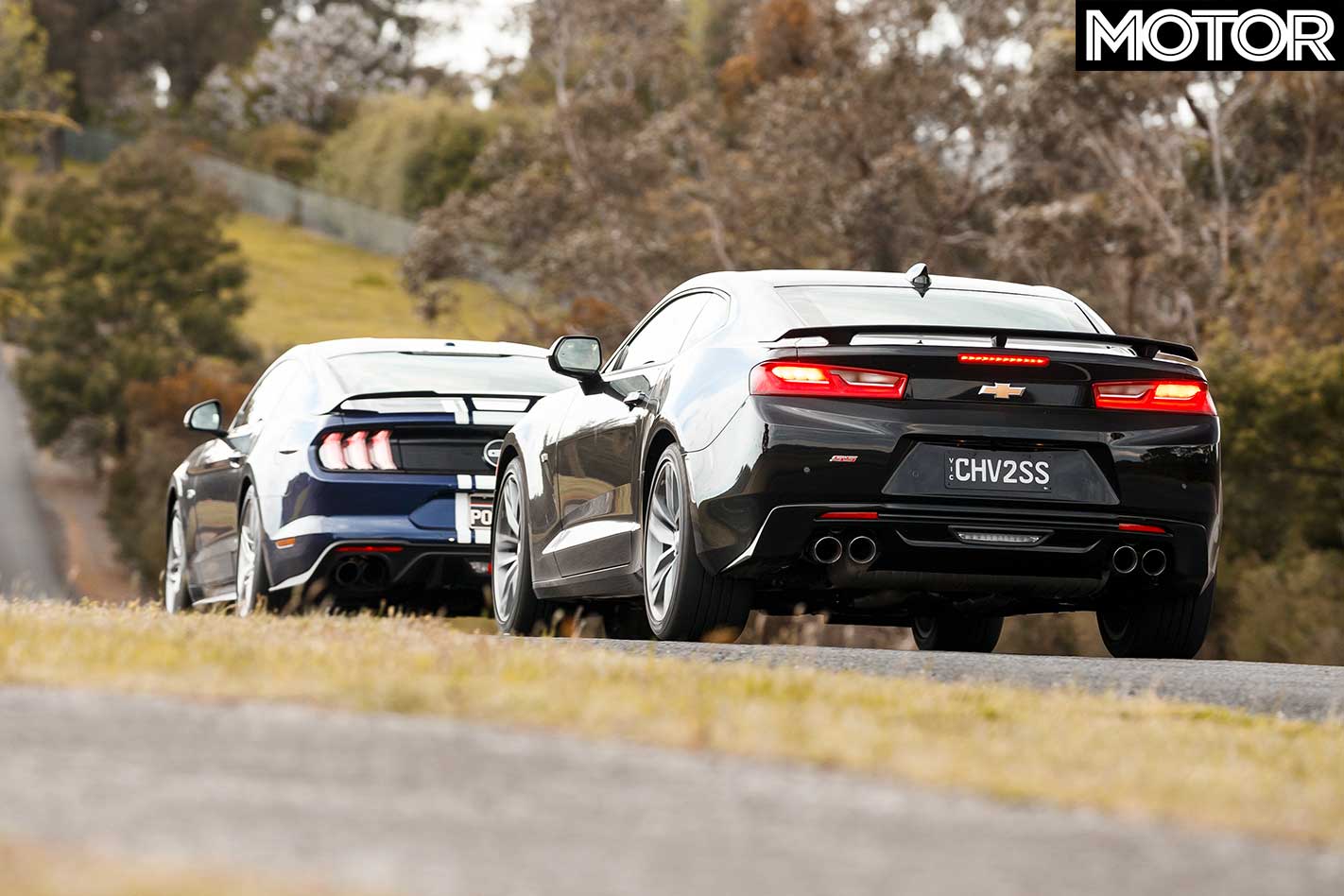
The transmission, too, thrives in a fast-paced environment. It comes alive when you attack in Sport Plus or Racetrack mode, firing down gears when you’re hard on the stoppers or quelling oversteer by skipping up through them.
Conversely, the Camaro’s chassis emerges as its true highlight. Thanks to GM’s Alpha platform, which succeeds the Zeta platform that underpinned the VE/VF Commodore, it has a longer wheelbase than the Mustang, resulting in a more central driving position.
This gives you a greater sense of control. Get the front to stick and the throttle dishes out small dabs of oversteer through a clutch-pack LSD. Meanwhile, the StabiliTrak ESP keeps things tidy with the same finesse as HSV’s Competition Mode in the Gen F2 range.
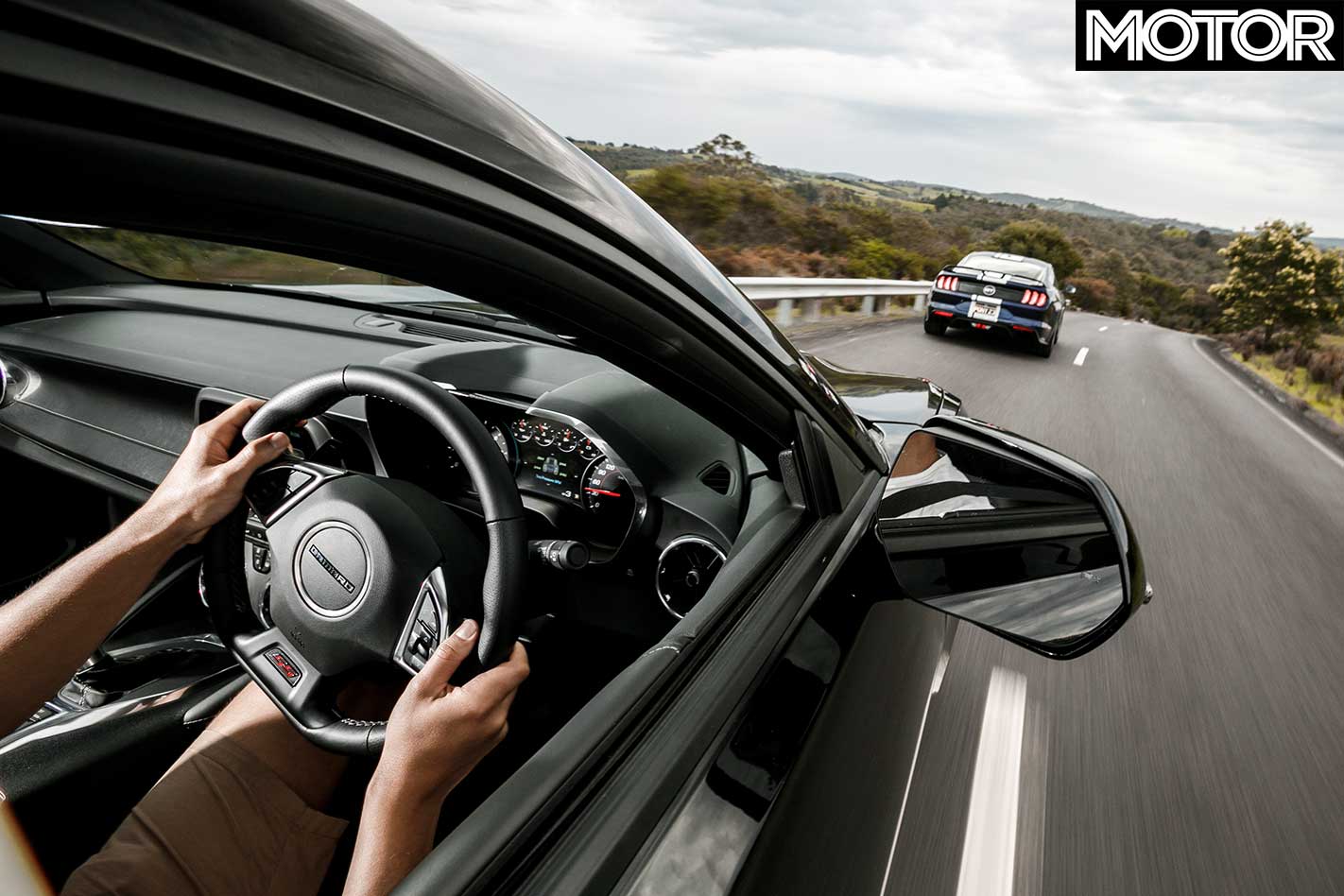
Its controls are easy to use. The brakes, comprising four-piston Brembos that clamp smaller discs, feel more natural and need a firmer squeeze. Meanwhile the steering is just okay. It prefers slow, precise inputs, and is heavy. Feel or feedback vanishes with the effort required to steer when in Sport or Track mode.
Back-to-back, the Camaro feels like the faster car and its speed is easier to extract. There’s more grip, feedback and the LT1’s midrange is devastatingly effective on the open road. Its gearbox also impersonates a race sequential ’box on upshifts, venting a pop of pressure from the exhaust, but it feels tardy on the fly, especially in manual mode. We’d also like its small paddles to respond with a nicer click, rather than their current arcade-ish tap. It’s dull.
Buyers might envision themselves sitting next to Playmate of The Year in the Camaro, but she’ll be swapping into the Mustang if the road surface is ugly. Its huge, low-profile run-flat Goodyears occasionally thud into holes while its FE3 suspension offers one type of ride: firm.
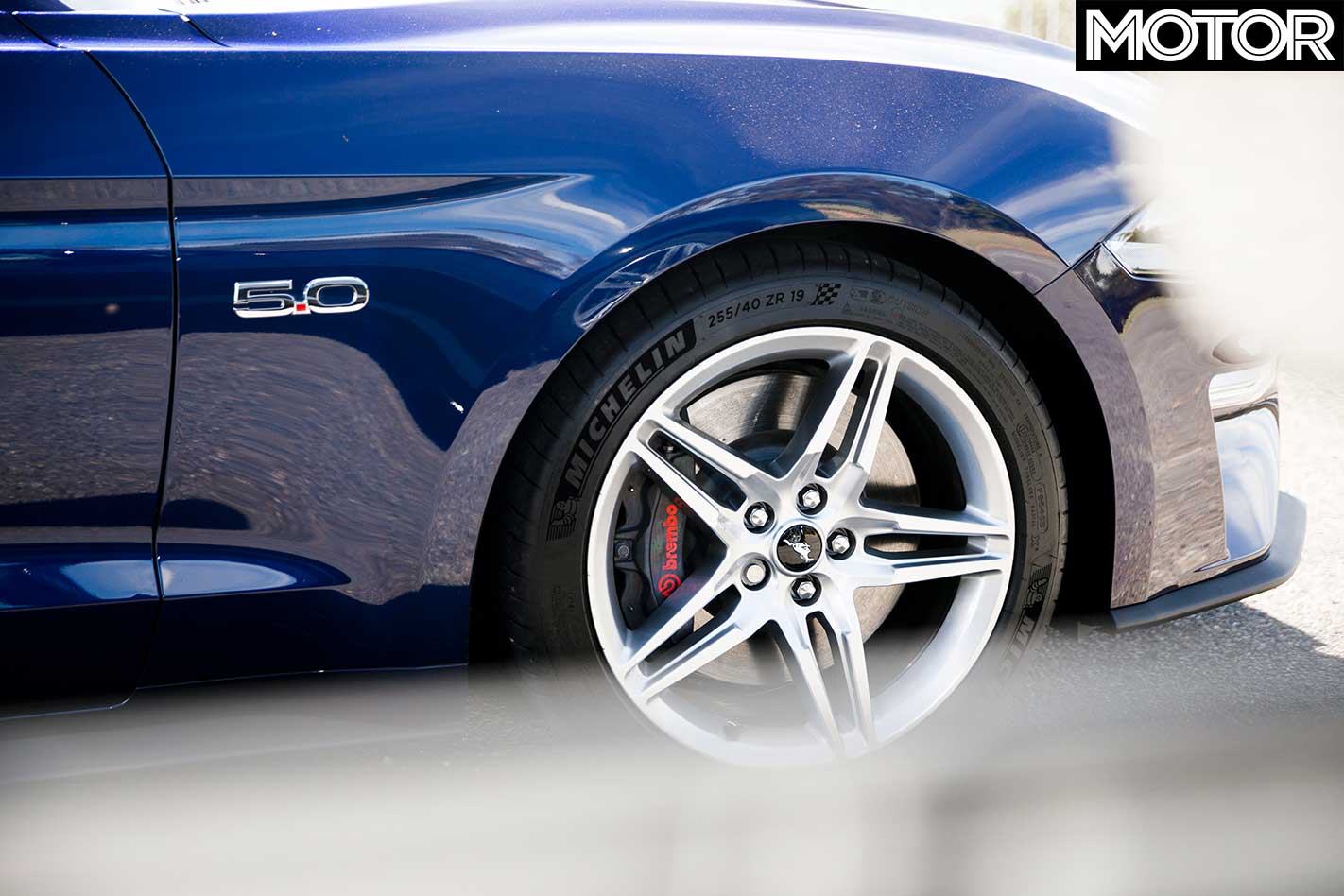
The Mustang’s adaptive suspension is smoother where the Camaro pogoes about, but you annoyingly can’t set the system separately to the drive mode. So if you want to dial up the commitment with the powertrain then you’re going to have to endure aggressive damping as well.
The active exhaust, at least, offers more customisation. Its 12.4-inch digital cluster lets you divide your exhaust, drive mode and steering to your liking. Its Quiet mode is much more noticeable than the Camaro’s equivalent Stealth setting but all other times the Coyote’s growl is an omnipresent force. Whether it’s throbbing on idle, tickling along at a cruise on a freeway, or feathering the throttle in a car park, you’re immersed in proper muscle-car theatre.
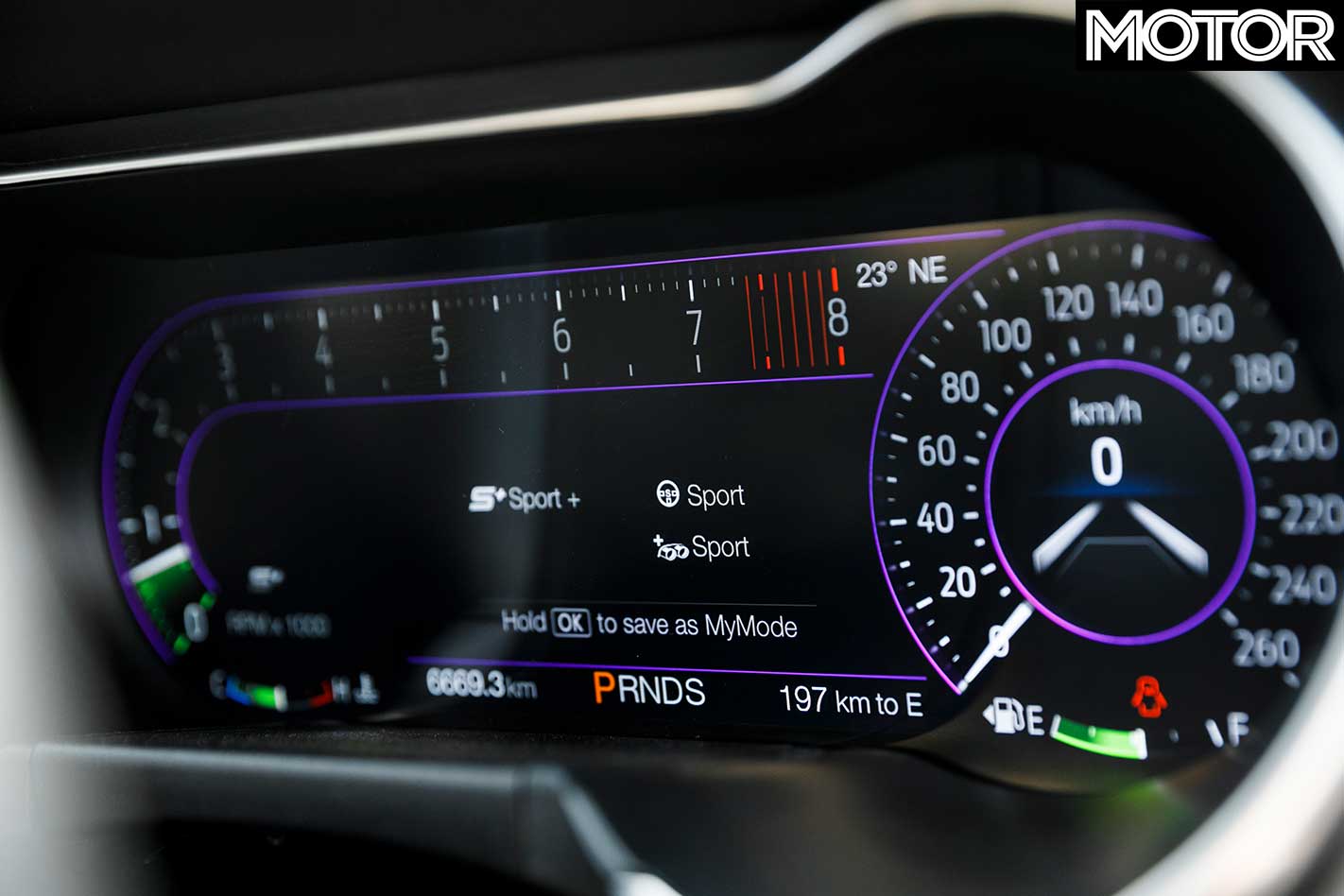
However, that’s not the case in the Camaro. In more relaxed situations it shuts down cylinders to run as a V4. You’ll hear an off-beat tick after the switch, then you’ll notice a lack of bottom-end response. At first it’s intriguing. After a week it’s mildly annoying. After a year we imagine ourselves madly scrolling Google pages in search of a tuner to disable it. Some don’t mind it – after all, it saves fuel – and keeps the Chevrolet small-block viable. Yet, we’re not sure you buy an SS for a part-time V8.
It might work only for a small portion of the time, but our problem is with when that is. Lazily cruising around on small throttle openings in a V8 muscle car is a big part of the experience. Trading that to gain a litre of fuel over each 100 kilometres on our road test, that involved some cruising and a good dollop of hard driving, isn’t worthy in our opinion.
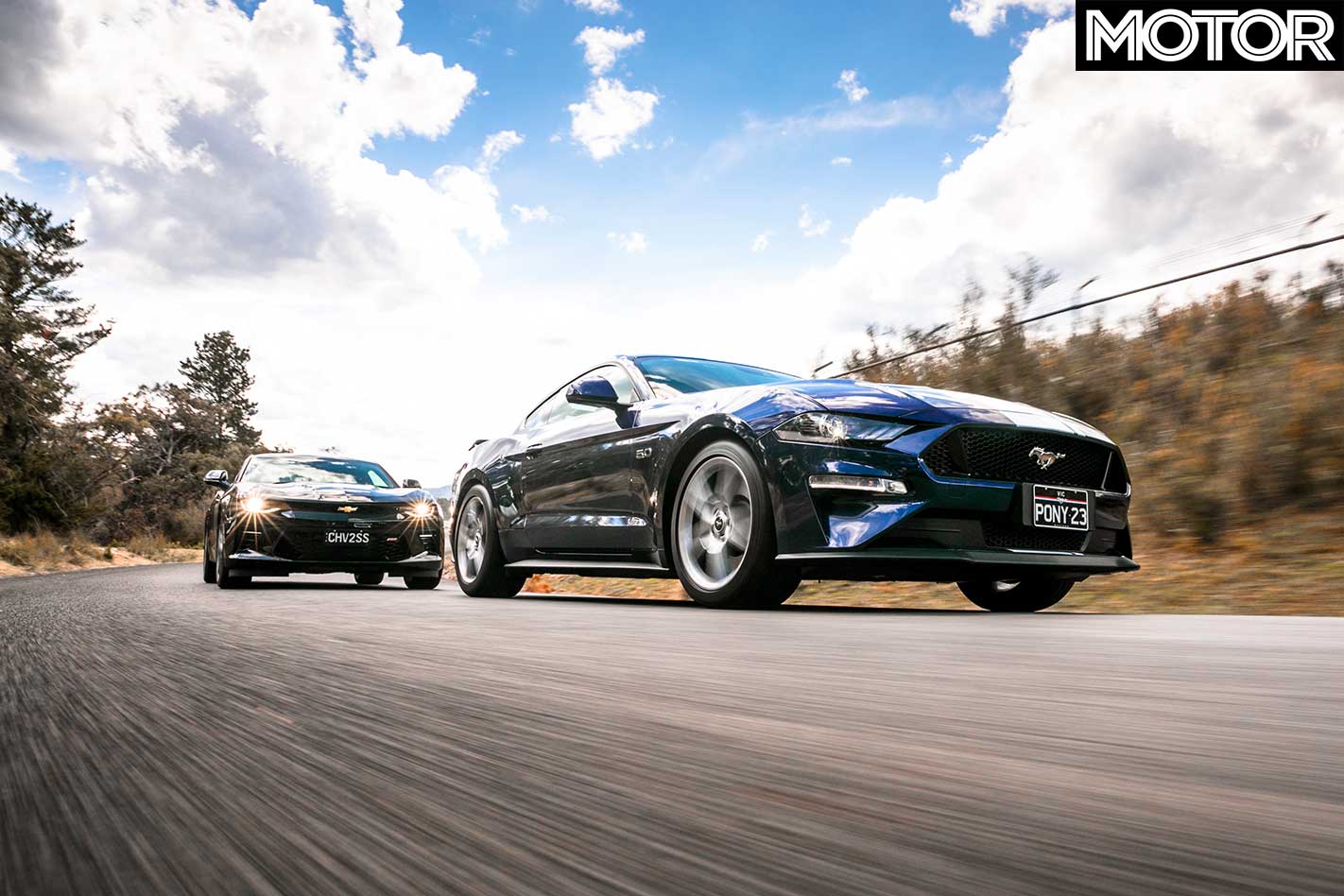
Even though this hurts the Camaro’s emotional appeal, it’s extremely hard to separate these two based on subjective feelings. They’re both icons, and either car’s looks would enchant the brand agnostic. The sixth-generation Camaro design, at least for the 2017 model year, channels the original car’s angular aggression. It will twist bystander’s necks everywhere it goes.
The Mustang’s cab-rearward silhouette is just as pretty in the metal. Lowering the bonnet this year might have smoothed off its iconic snout, but regular attention from strangers confirms its retro design is instantly recognisable.
So let’s look at this more objectively. Yes, the Camaro is faster and easier to approach on the limit. Its engine delivers fearsome mid-range and we can’t wait to explore its potential with a 10-speed transmission.

The right-hand drive swap doesn’t penalise it, either. Besides some minor flaws on our ‘pilot’ press car, like the rough looking microphone holes in the right A-pillar, the Camaro feels as if it emerges from Michigan already in right-hand drive.
But it doesn’t, and it costs $85,990, or $20K more than a $65,990 automatic Mustang GT. This forces HSV to position the Camaro as a more exclusive product than the Mustang. It’ll certainly be a rarer car, HSV is expecting to sell 1000 per year when Ford has already sold 18,000 Mustangs with a healthy chunk of them being the V8. But it’s hard to believe its premium stance when it lacks all the features found in the Mustang. Like sat-nav, for instance.
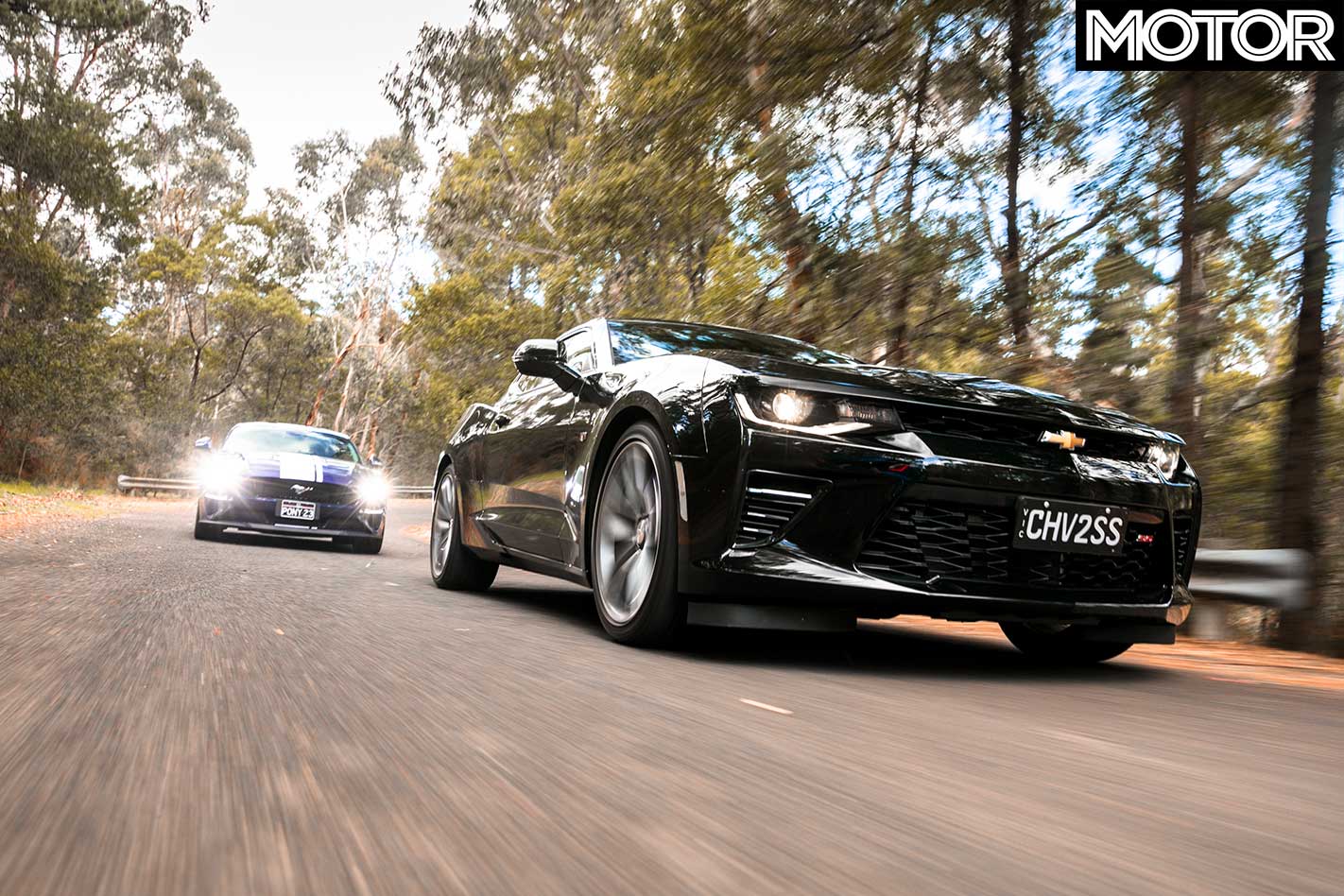
Our heavily optioned Ford closes the price gap to $10K. But if it were our car it’d only have the electric Recaro seats and maybe the adaptive suspension. Maybe.
Okay, the Mustang lacks polish when you dig in your spurs, but if the measure of a muscle car is how it makes you feel, then dollar-for-dollar it wins. It rides better, looks great and sounds grouse for much less. The Camaro may be lightning fast, but thunder always gets the last say.
Fast Facts
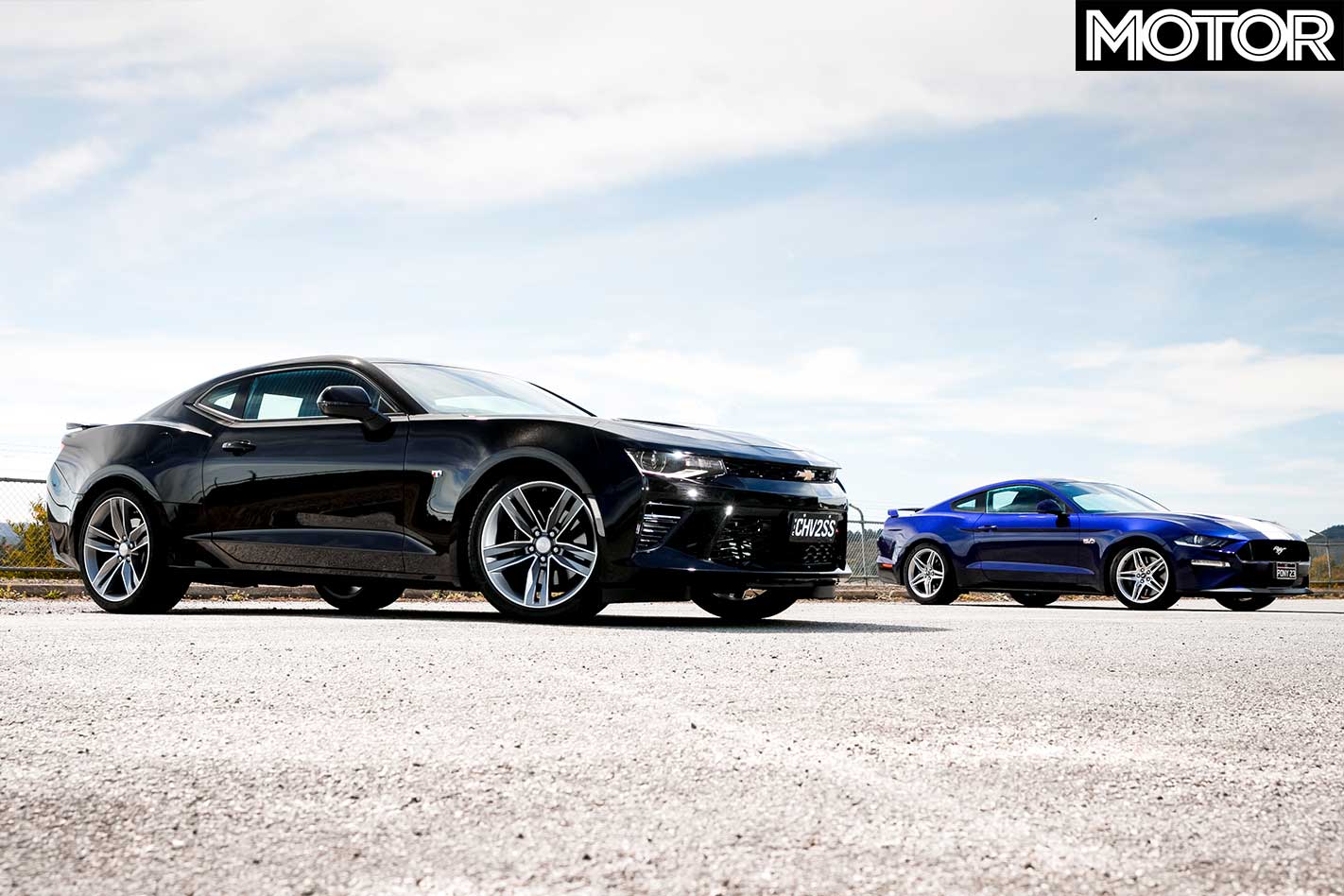
| u00a0 | Chevrolet Camaro 2SS | Ford Mustang GT |
| Body | 2-door, 4-seat coupe | |
| Drive | rear-wheel | |
| Engine | 6162cc V8, OHV, 16v | 5038cc V8, DOHC, 32v |
| Bore x Stroke | 103.25 x 92mm | 93.0 x 92.7mm |
| Compression | 11.5:1 | 12.0:1 |
| Power | 339kW @ 5700rpm | 339kW @ 7000rpm |
| Torque | 617Nm @ 4600rpm | 556Nm @ 4600rpm |
| Power/Weight | 198kW/tonne | 193kW/tonne |
| Transmission | 8-speed automatic | 10-speed automatic |
| Weight | 1710kg | 1756kg |
| Suspension (f) | struts, dampers, anti-roll bars | struts, adaptive dampers, anti-roll bar |
| Suspension (r) | multi-links, dampers, anti-roll bars | multi-links, adaptive dampers, anti-roll bar |
| L/W/h | 4784/1897/1348mm | 4789/1916/1396mm |
| Wheelbase | 2811mm | 2720mm |
| Tracks | 1600/1597mm (f/r) | 1642mm (f/r) |
| Steering | electrically-assisted rack-and-pinion | |
| Brakes (f) | 345mm ventilated discs, 4-piston calipers | 380mm ventilated discs, 6-piston calipers |
| Brakes (r) | 339mm ventilated discs, 4-piston calipers | 330mm ventilated discs, single-piston calipers |
| Wheels | 20.0 x 8.5-inch (f); 20.0 x 9.5-inch (r) | 19.0 x 9.0-inch (f); 19.0 x 9.5-inch (r) |
| Tyre Sizes | 245/40 ZR20 95Y (f); 275/35 ZR20 98Y (r) | 255/40 ZR19 (f); 275/40 ZR19 (r) |
| Tyres | Goodyear Eagle F1 Asymmetric 3 | Michelin Pilot Sport 4S |
| Price | $85,990 | $75,640 |
| Pros | Grip; meaty mid-range; looks; driving position; clever ESP; upshift noise | Top-end power delivery; noise; looks; equipment; modes; value |
| Cons | Price; ride; AFM; steering weight | On-limit handling; fussy gearbox |
| Rating | 4 out of 5 stars | 4 ouf ot 5 stars |
The Strip
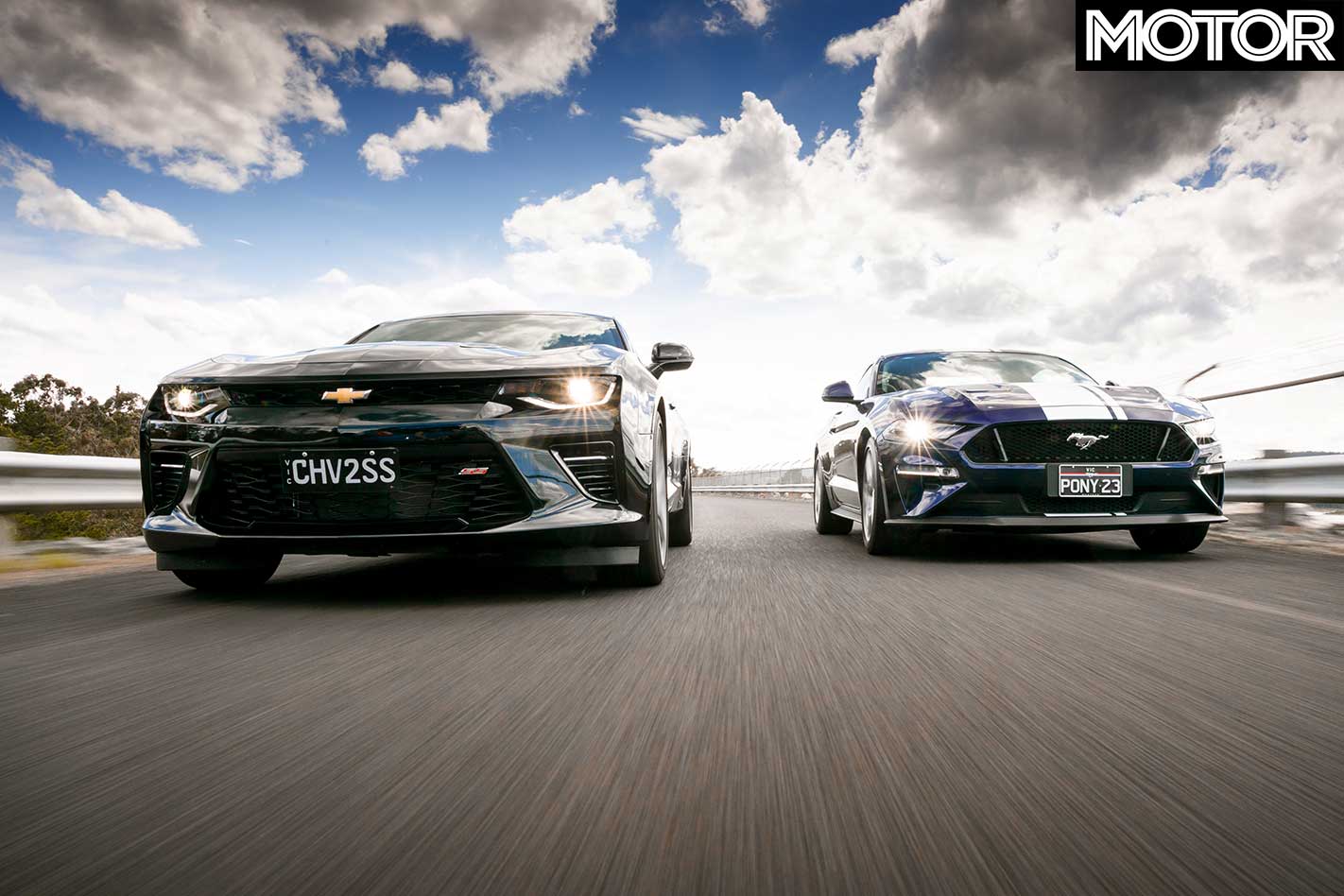
| u00a0 | Chevrolet Camaro 2SS | Ford Mustang GT | |
| 0-10km/h | 0.43sec | 0.41sec | |
| 0-20km/h | 0.84sec | 0.83sec | |
| 0-30km/h | 1.33sec | 1.27sec | |
| 0-40km/h | 1.64sec | 1.74sec | |
| 0-50km/h | 2.04sec | 2.22sec | |
| 0-60km/h | 2.50sec | 2.71sec | |
| 0-70km/h | 3.00sec | 3.15sec | |
| 0-80km/h | 3.50sec | 3.71sec | |
| 0-90km/h | 4.07sec | 4.32sec | |
| 0-100km/h | 4.68sec | 4.90sec | |
| 0-110km/h | 5.47sec | 5.56sec | |
| 0-120km/h | 6.18sec | 6.29sec | |
| 0-130km/h | 6.96sec | 7.01sec | |
| 0-140km/h | 7.86sec | 7.79sec | |
| 0-150km/h | 8.87sec | 8.69sec | |
| 0-160km/h | 9.93sec | 9.61sec | |
| 0-170km/h | 11.06sec | 10.70sec | |
| 0-180km/h | 12.44sec | 11.82sec | |
| 0-400m | 12.8sec @ 181.76km/h | 12.79sec @ 187.47km/h | |
| 80-120km/h (Drive) | 2.62sec | 2.54sec | |
| 100-0km/h | 33.79m | 35.83m | |
| Speed in Gears | |||
| 1st | 68km/h @ 6500rpm | 62km/h @ 7400rpm | |
| 2nd | 104km/h @ 6500rpm | 98km/h @ 7400rpm | |
| 3rd | 149km/h @ 6500rpm | 136km/h @ 7400rpm | |
| 4th | 183km/h @ 6500rpm | 165km/h @ 7400rpm | |
| 5th | 244km/h @ 6500rpm | 192km/h @ 7400rpm | |
| 6th | 290km/h @ 6080rpm* | 229km/h @ 7400rpm | |
| 7th | 290km/h @ 5175rpm* | 250km/h @ 6320rpm* | |
| 8th | 290km/h @ 3950rpm* | 250km/h @ 5380rpm* | |
| 9th | N/A | 250km/h @ 4360rpm* | |
| 10th | N/A | 250km/h @ 4050rpm* | |
Heathcote Raceway, 16˚C, dry. Driver: Scott Newman/Louis Cordony *Manufacturer’s claim Official timing supplier – VBOX Australia
In Detail
2018 Chevrolet Camaro 2SS
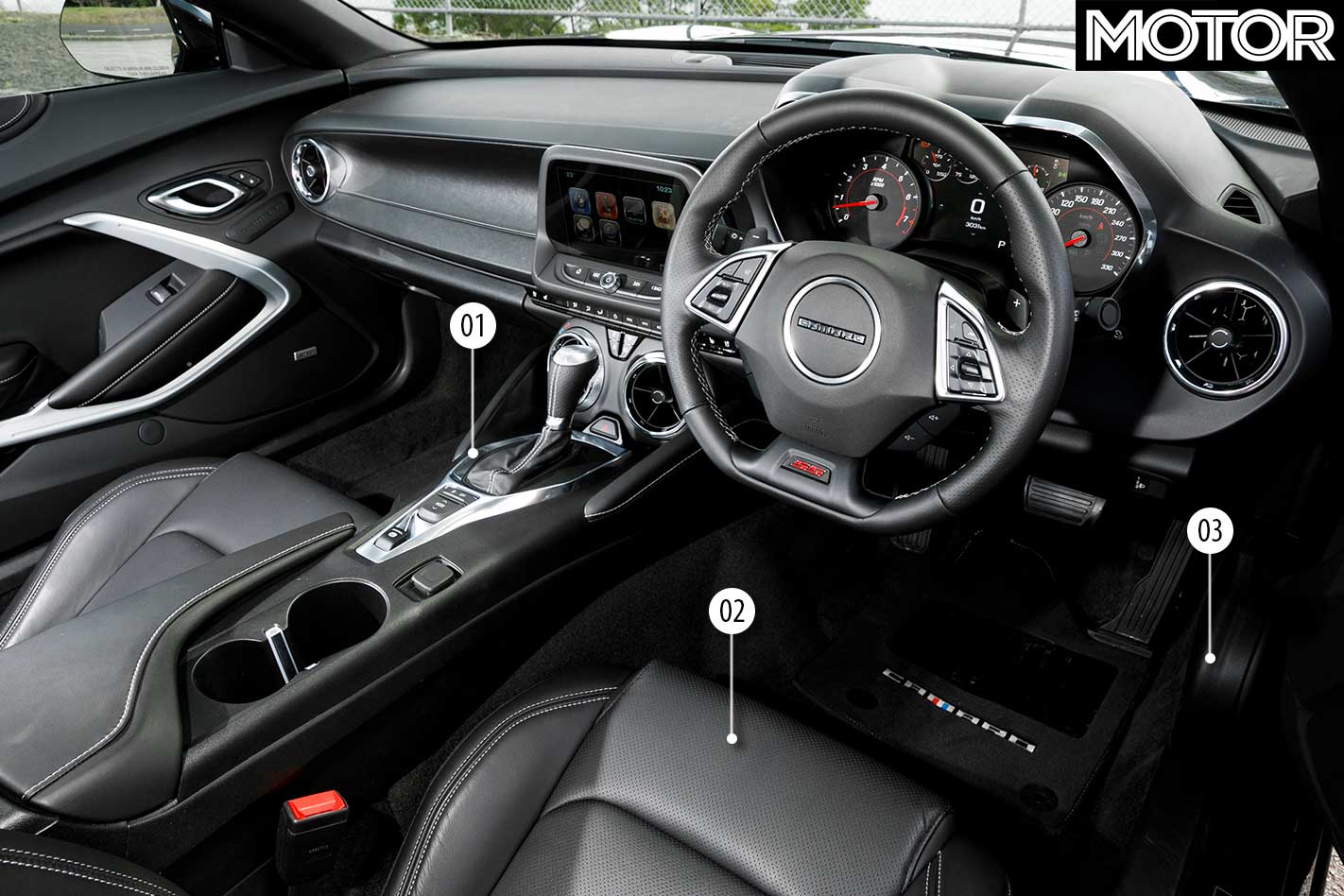
01 – LHD CLUES There’s a handful that hint at the conversion. The indicator clicking sound comes from the passenger side of the dash. The ‘P-R-N-D’ is on the wrong side and somewhat hidden by the gear lever
02 – THE SEATS Strike a good balance between support and accommodating size, as they’ll clearly fit humans bigger than the average MOTOR tester who, for reference, weighs 80kg and spans five foot 10 inches
03 – FOOTWELL HSV widens the footwell before fitting new pedals. The seating position is fantastic, with no compromises from having started life in left-hand drive. Headroom’s a bit tight with a helmet, though
2018 Ford Mustang GT
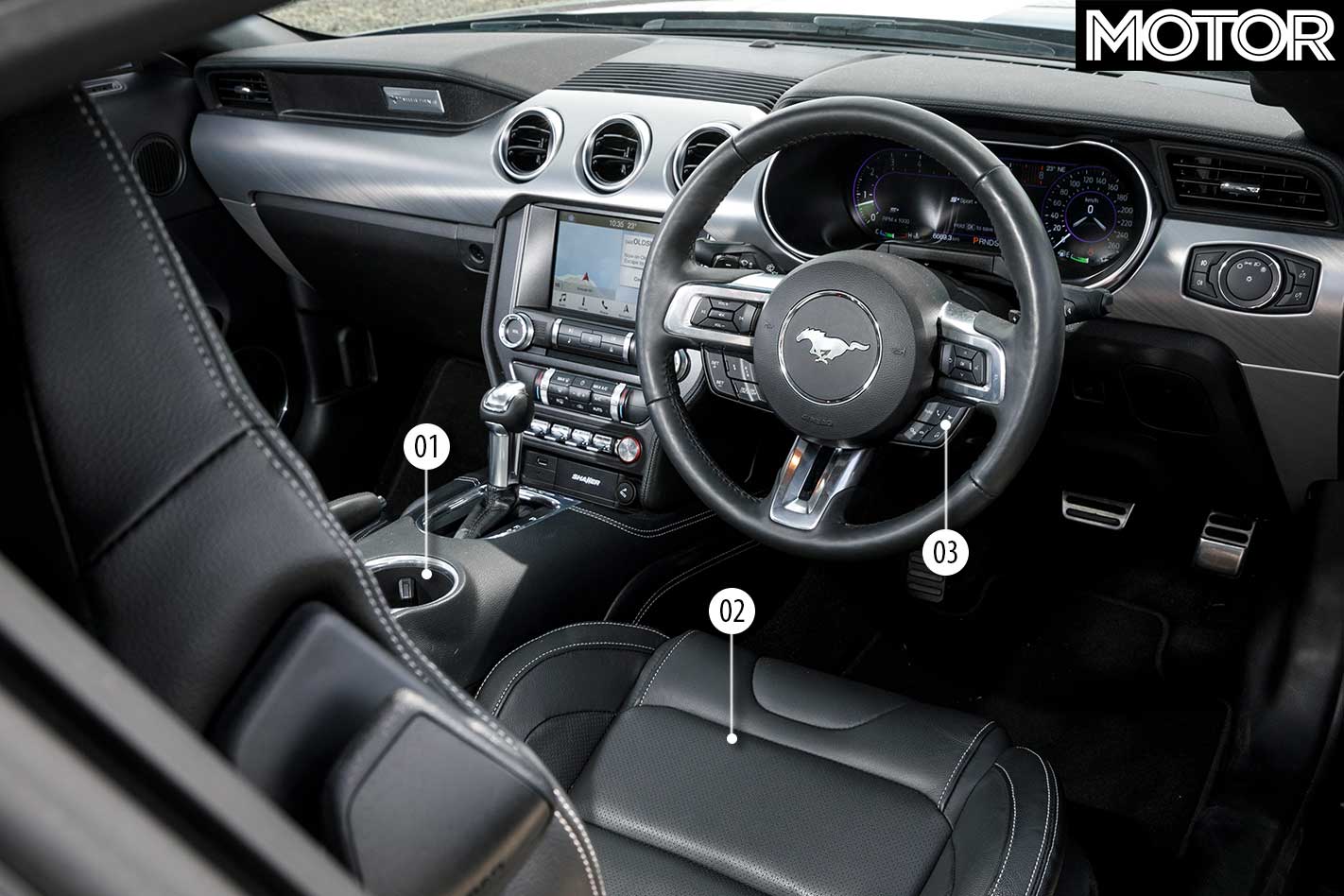
01 – QUIRKS Like the Camaro, the cup holders rest on the centre console’s ‘wrong’ side. You sit a lot higher in the Mustang than you do the Camaro, however forward and rearward visibility is better
02 – NEW GEAR 2018 Mustang interior highlights are digital cluster and (optional) Recaro seats. The 12.4-inch screen offers plenty of fun customising the display; there’s all the telemetry you’ll ever want
03 – GOODIES There’s radar cruise control and auto emergency brake. Upgraded interior over regular GT in America helps lift ambience but the Camaro’s interior, even with less equipment, feels slightly more premium


